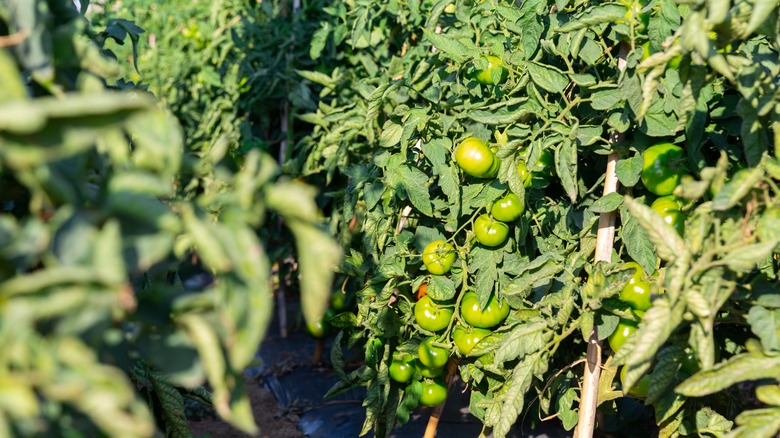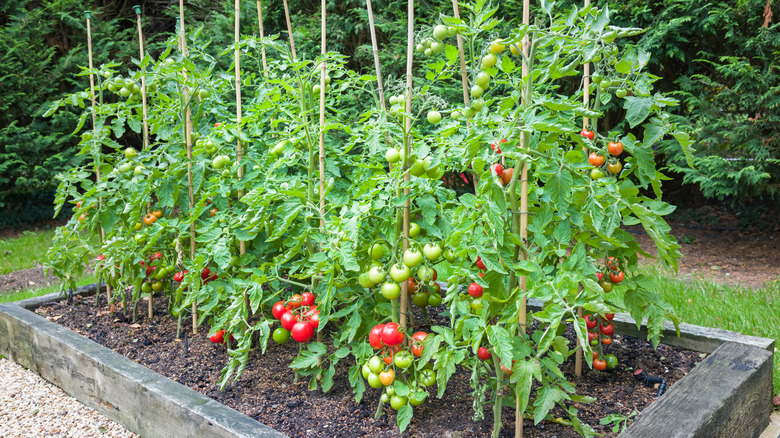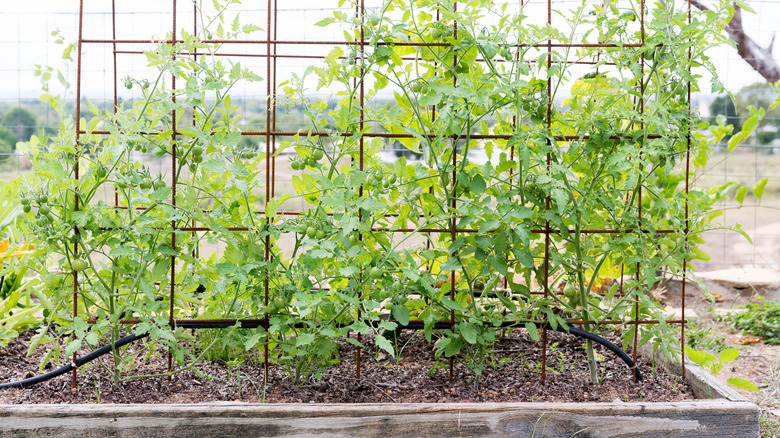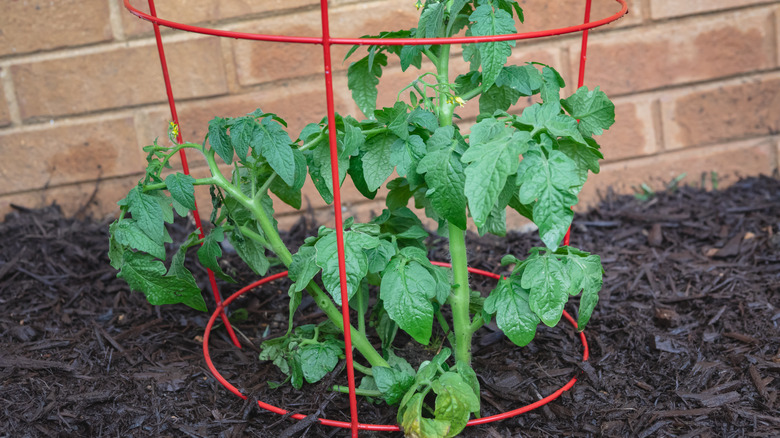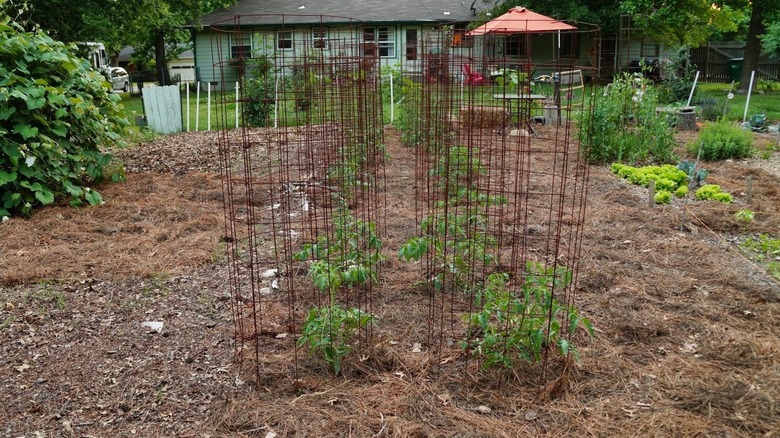5 Ways To Support Your Tomato Plants
We may receive a commission on purchases made from links.
With over 10,000 varieties of tomatoes on the market, it's clear this juicy fruit is a staple in many gardens. If you asked 100 gardeners what the best variety is, you'll probably get about 100 different answers, and the same goes for ways to support those plants. Each experienced gardener has a favorite method which is, of course, the best.
When planting, there are a few things to consider regarding what kind of tomato supports you want to use. Some options last for decades, while others need to be replaced each year. If you're on a budget your first year, some materials might be cost-prohibitive, yet you can find others for free. Another thing to think about is the kind of tomatoes you plan to grow. Most tomatoes fall into one of two categories: determinate or indeterminate. Determinate tomatoes grow to a specific height and only produce a set amount of tomatoes each season. Indeterminate varieties grow and produce for as long as the weather is favorable. The labels on your seed packets or plant tag should identify the cultivar as one of these options. With that in mind, you can decide how best to support your tomatoes.
Florida weave
Although the Florida weave sounds like something you might request from your hair stylist, it's actually a popular method of trellising tomatoes. This process saves space and time, and it's best suited for determinate tomatoes because they grow more like bushes than vines and do not get too tall. For the Florida weave, you'll need sturdy metal stakes that are about 6 feet tall, like rebar or T-posts, to provide support. Wood stakes are a less expensive option, but they do not last as long. Jute twine or cotton string helps keep tomatoes upright between the posts.
To build your Florida weave, install your posts 2 to 3 feet apart. To make sure your trellis stays upright through wind and rain, drive your stakes into the ground about 12 inches deep, if possible. Place two small tomato plants between each stake. Once your plants reach about 1 foot tall, or begin to fall over, start weaving your twine. Tie the twine to the end stake, then weave it in front of the first two tomatoes. Wrap your twine around the next stake, and behind the next two plants. Once you reach the end post, wrap your twine around that support and continue this process going in the other direction until there is twine supporting the front and back of all your tomatoes, securing it again around the first stake. Add another layer of twine about every 8 inches as your plants grow taller and until they reach their full height.
Bamboo
Like the Florida weave, bamboo is best for determinate tomatoes. This product is also an exceptionally budget-friendly way to keep your tomatoes upright. Sometimes you can find someone giving away bamboo that they have cut from their yard. If that is not an option, you can find stakes on Amazon or at most garden centers.
There are a few ways to use bamboo to support your tomato plants, but the simplest way to use it is as a single stake. Drive the post into the ground about 12 inches deep. As your determinate tomato plant grows, secure the main stem to the bamboo using tomato clips like these, which are not tight enough to damage the stem, but are secure enough to keep the tomato plant upright. You can also use materials you already have, especially something that stretches a bit like used elastic or pantyhose cut into strips and loosely tied around the stem. In a pinch, zip ties will work as well; just be sure you don't secure them too tightly and cause damage to the plant.
Vertical trellis
Since indeterminate tomato varieties can grow vines up to 20 feet long, a vertical trellis is an excellent way to save space while allowing your tomatoes to grow as much as possible. There are plenty of vertical trellis options available, and the great thing about using them with indeterminate varieties is that you can prune them to fit your available space, if needed, without losing some of your harvest. In contrast, if you prune determinate varieties — which only produce a set number of fruits per season — any pruning will reduce the amount of food you get from your garden.
Ornamental trellises in almost any shape or style make an attractive addition to the garden, while hoops made of cattle panels are an inexpensive option. The key to using a vertical trellis to support your indeterminate tomatoes is to remember that, although they are a vine, they do not have tendrils to help them climb. Like using a single stake, you will need to secure individual vines to your trellis as the plant grows in order to keep it off the ground.
Standard tomato cages
Perhaps the product on this list that's easiest to find are standard tomato cages. In the spring, they pop up like seedlings at nearly every grocery store, garden center, and discount retailer. Basically, everywhere you need to go, there they are. Although cages are now available in different shapes, colors, and sizes, their basic functions remain the same. They have metal stakes at the bottom to secure them to the ground, they are made to encircle the tomato plant, and they are generally easy to manage. Standard tomato cages do not require any other equipment like clips or large stakes. These items offer an all-in-one support system for tomato plants.
Standard tomato cages work well for determinate varieties of tomatoes that do not get much taller than 4 feet, which is about the largest size cage you can get. Indeterminate varieties can outgrow one of these products quickly if you do not prune them frequently. If you're looking for a basic support for your Roma or other determinate tomatoes, this is the easiest option.
Concrete remesh cages
If you're interested in a heavy-duty product to support determinate or indeterminate varieties that will last for decades, consider making your own cages out of concrete remesh. Although this is a DIY project and the most expensive on this list, it's also the longest-lasting and most durable. In construction, remesh is used to improve the structure of concrete slabs, so you can find it in the contractor's section of your hardware store. Aside from its durability, a major benefit of making a cage out of this material is that the space between wires is big enough to get your hands through for minor pruning and harvesting.
To build your own tomato cages out of wire remesh, you can buy a sheet and roll it into a circle, securing the ends together. Plant your tomatoes, then place the cage over them. If you live in an area where high winds are a concern, secure the cage by driving a few pieces of rebar into the ground and connecting them to the cage with wire.

